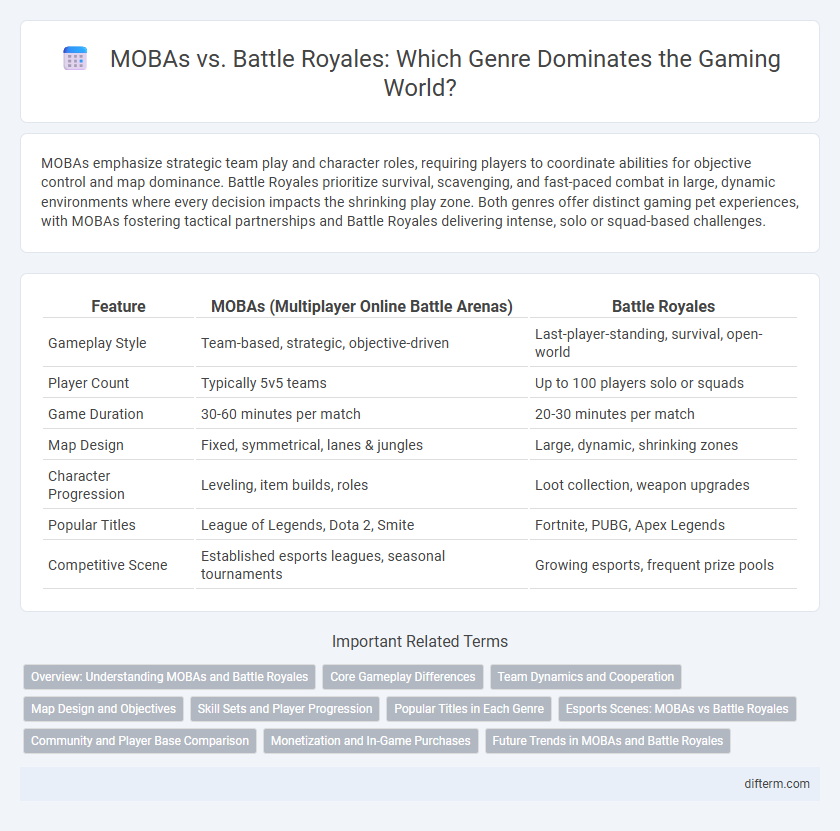MOBAs emphasize strategic team play and character roles, requiring players to coordinate abilities for objective control and map dominance. Battle Royales prioritize survival, scavenging, and fast-paced combat in large, dynamic environments where every decision impacts the shrinking play zone. Both genres offer distinct gaming pet experiences, with MOBAs fostering tactical partnerships and Battle Royales delivering intense, solo or squad-based challenges.
Table of Comparison
| Feature | MOBAs (Multiplayer Online Battle Arenas) | Battle Royales |
|---|---|---|
| Gameplay Style | Team-based, strategic, objective-driven | Last-player-standing, survival, open-world |
| Player Count | Typically 5v5 teams | Up to 100 players solo or squads |
| Game Duration | 30-60 minutes per match | 20-30 minutes per match |
| Map Design | Fixed, symmetrical, lanes & jungles | Large, dynamic, shrinking zones |
| Character Progression | Leveling, item builds, roles | Loot collection, weapon upgrades |
| Popular Titles | League of Legends, Dota 2, Smite | Fortnite, PUBG, Apex Legends |
| Competitive Scene | Established esports leagues, seasonal tournaments | Growing esports, frequent prize pools |
Overview: Understanding MOBAs and Battle Royales
Multiplayer Online Battle Arenas (MOBAs) emphasize team-based strategy, player roles, and objective control within a fixed map, promoting deep tactical gameplay and coordination. Battle Royales center on survival instincts, featuring large-scale matches where players scavenge resources and eliminate opponents to be the last person or team standing, often on expansive, dynamic maps. Both genres have distinct mechanics and player dynamics, attracting varied audiences who prioritize either strategic depth or fast-paced, high-stakes combat scenarios.
Core Gameplay Differences
MOBAs emphasize strategic team-based objectives, hero roles, and map control through lanes and towers, requiring coordinated teamwork and resource management. Battle Royales prioritize survival and exploration in a large, shrinking map where players scavenge for weapons and gear, relying on individual skills and quick decision-making. These core gameplay differences define MOBAs as tactical and objective-driven, while Battle Royales focus on dynamic combat and adaptability in unpredictable environments.
Team Dynamics and Cooperation
MOBAs emphasize strategic team dynamics and precise role coordination, requiring players to synergize abilities and execute complex tactics for objective control. Battle Royales highlight flexible cooperation with fluid team roles, promoting adaptive communication and rapid decision-making amid chaotic environments. Both genres demand strong teamwork, but MOBAs rely on structured coordination while Battle Royales focus on dynamic, situational collaboration.
Map Design and Objectives
MOBA maps typically feature symmetrical designs with clearly defined lanes, jungles, and bases, emphasizing strategic control points and team objectives such as turret destruction and inhibitor capture. Battle Royale maps are expansive, often featuring diverse terrains and dynamic zones that shrink over time, pushing players towards survival and resource-gathering objectives. Map design in MOBAs encourages coordinated team fights and objective control, while Battle Royales prioritize exploration, adaptability, and last-player-standing mechanics.
Skill Sets and Player Progression
MOBAs emphasize strategic teamwork, precise mechanical skills, and in-depth knowledge of diverse hero abilities, requiring players to master complex character roles and map control for effective progression. Battle Royales prioritize adaptive aiming, spatial awareness, and survival tactics, encouraging fast decision-making and versatile combat skills as players advance through evolving in-game scenarios. Player progression in MOBAs is often measured by ranked play and hero mastery, whereas Battle Royales focus on improving individual performance metrics like kill/death ratios and match survival times.
Popular Titles in Each Genre
Popular MOBA titles include League of Legends, Dota 2, and Smite, each offering strategic team-based gameplay with distinct heroes and abilities. In the Battle Royale genre, Fortnite, PUBG, and Apex Legends dominate with fast-paced survival mechanics and expansive maps. Both genres attract massive player bases and esports followings, highlighting diverse competitive gaming preferences.
Esports Scenes: MOBAs vs Battle Royales
MOBAs like League of Legends and Dota 2 dominate esports with large, established tournaments offering multi-million dollar prize pools and a well-structured competitive ecosystem. Battle Royales such as Fortnite and Apex Legends attract massive viewer numbers due to fast-paced gameplay and frequent seasonal events, though their esports scenes are relatively less mature. The strategic depth and team coordination in MOBAs contrast with the high-intensity, survival-focused tactics in Battle Royales, shaping distinct audiences and sponsorship dynamics within the esports industry.
Community and Player Base Comparison
MOBAs like League of Legends and Dota 2 boast highly competitive, strategy-driven communities with millions of active players fostering teamwork and communication. Battle Royale games such as Fortnite and Apex Legends attract a more diverse and expansive player base emphasizing fast-paced, survival-focused gameplay. The MOBAs' player communities tend to be more niche and deeply engaged, while Battle Royales maintain broader appeal and higher global user acquisition rates.
Monetization and In-Game Purchases
MOBA games like League of Legends primarily generate revenue through cosmetic in-game purchases such as skins, champions, and event passes, fostering long-term player engagement without affecting gameplay balance. Battle Royale titles like Fortnite emphasize season passes, battle passes, and limited-time cosmetic items to drive consistent revenue streams while encouraging frequent content updates. Both genres leverage microtransactions to monetize player progression and personalization, but MOBAs focus more on character unlocks and upgrades, whereas Battle Royales prioritize skin variety and seasonal content.
Future Trends in MOBAs and Battle Royales
Future trends in MOBAs focus on enhanced AI-driven matchmaking and cross-platform integration to improve player connectivity and competitive balance. Battle Royales are evolving with expanding map dynamics, incorporating real-time environmental changes and deeper narrative elements to boost player immersion. Both genres are leveraging augmented reality and cloud gaming technologies to redefine accessibility and gameplay experience.
MOBAs vs Battle Royales Infographic

 difterm.com
difterm.com